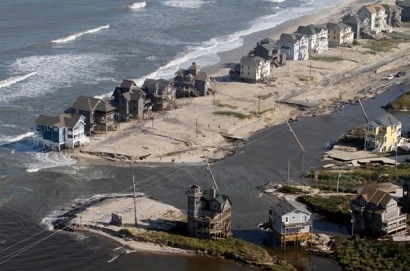
While Hurricane Irene lashed the eastern Seaboard and the Canadian Maritimes over the weekend, killing 3 1 while causing extensive flooding, property damage and economic disruption, there have been absolutely no reports of damage to renewable energy facilities.
Typical was the response of Matthew Lumley, communications director for the Fundy Ocean Research Centre for Energy in Halifax, Nova Scotia.
“No damage,” he wrote in an email early Monday morning. “The facility is intact, and there are no turbines in the water at present.”
Up and down the US Coast Irene passed over the proposed sites of several wind projects, but none had progressed so far as to be in harm’s way.
But that’s not to say Hurricane Irene doesn’t amount to an energy story.
By the time the hurricane was downgraded to a tropical storm and began to move off the mainland for a final time, more than 5.9 million were without power in 14 states.
According to the US Dept. of Energy, as Irene passed over Maryland on Saturday, the Calvert Cliffs Nuclear Power Plant Unit 1 tripped when a large piece of siding blew off the building and hit a main transformer.
While the facility, which is located on the on the western shore of the Chesapeake Bay near Lusby, Calvert County, Maryland was still deemed “safe and stable”, an “unusual event was nevertheless declared.
After the mishap, the facility’s Unit 2 was stable and operating at 100 percent power, the agency said.
Elsewhere one oil refinery has shut down (ConocoPhillips Linden, NJ) while three other refineries were operating at reduced rates during and after the storm.
Among those watching Irene’s progress from afar was Boyd Cohen, CEO of CO2 IMPACT, a carbon origination company based in Vancouver, Canada and Bogota, Colombia.
Cohen is also the co-author of Climate Capitalism: Capitalism in the Age of Climate Change.
As people in Irene’s path hunkered down, Cohen collected his thoughts and wrote a blog entry. In it, he spoke about how a smart grid – another major interest in the US that is in but the early stages of development, would provide “a major opportunity to minimize power loss for storm-affected communities.
“Triple Pundit [on whose website he was writing] has been active in promoting dialog about smart grids over the past few years,” Cohen said. “Southern California Edison defines a smart grid as ‘an increasingly intelligent and highly automated electric power system that utilizes technology advancements in telecommunications, information, computing, sensing, controls, materials, in addition to other grid technologies.”
“Of course the loss of energy during a prolonged storm can lead to significant threats to the health and safety of our communities,” Cohen wrote.
“This comes from disrupted supplies of potable water (particularly people living in high rises), loss of phone service for emergency calls, loss of air conditioning, and threats to people who depend on medical machines for survival,” he continued.
Cohen pointed his readers to another website, that of the Smart Grid Information Clearinghouse, which has an interactive map illustrating smart grid projects underway in the US from smart metering to advanced transmission and distribution systems.
As is the case with wind, there are several proposed smart grid projects that are currently under consideration that would have been in the path of Irene had they come to fruition sooner.
To advocates like Cohen, the benefits of a smart grid are as clear as can be.
“Smart grids enable real-time digital transmission of data regarding grid performance, locations of problem areas, and mechanisms for redistributing energy,” he wrote. “They are also commonly accompanied by enhanced ability to ‘plug-in’ multiple energy sources including distributed energy.”
For Cohen, the takeaway from Hurricane Irene and the other, more intense storms that are now attributed to climate change, is that we need to begin preparing for the “new normal.”
“Resilient communities, cities and countries will take proactive steps to mitigate the risks of intense storms, draughts and related weather impacts from climate change,” Cohen wrote. “Smart grids pose a significant opportunity to modernize our energy distribution systems in ways that accommodate new energy sources and importantly minimize the impacts from major weather events.”
To underscore his point, Cohen quoted Luke Clemente from GE who stated following severe storms in Georgia in 2010 that, “managing the inconvenience and danger of power outages caused by storms like the ones we’re experiencing this week is a great challenge for the utility industry.
“As Mother Nature turns out the lights across the country, we are reminded of the broader impact that a smarter grid can have on consumers,” Clemente continued. “Today’s smart grid solutions can reduce the number of customers affected by power outages and minimize the impact of outages that do occur by getting power online quicker than ever before.”
Cohen, and no doubt many others currently without power in the Eastern US, agree.
For additional information:

